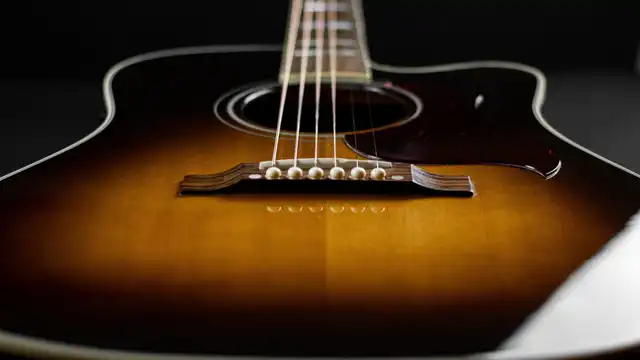Acoustic Guitar String Gauges: Which Is Best For You?


While it may seem inconsequential to beginners, the strings you put on your acoustic guitar have a massive impact on your tone and playing. Unlike electric guitars where tone can easily be changed via amps, pedals, and knobs, acoustic guitars are typically more limited. They are remarkably simple instruments—just wood, strings, and the player’s touch. Because of this, each of those factors, including strings, are incredibly important to your tone and playing.
Looking more closely at strings, material and gauge are the two main distinctions between strings. We already did a deep dive on phosphor bronze vs 80/20 acoustic guitar strings, so let’s take some time to analyze string gauge instead. In this guide, we will compare the four most popular acoustic guitar strings gauge and what/who they are good for, so you can choose the best acoustic guitar string gauge for you and your guitar.
Extra Light Gauge (10-50)
Up first are extra light gauge strings (10-50). Extra light strings first and foremost are easy to play. Because they are smaller, they require less force to fret a note. This makes them a great choice for beginners who have yet to build the finger strength and calluses of more experienced guitar players. They are also easier to bend, which is great for beginners or those who like to bend more than a whole step.
However, their playability comes at a cost. Extra light strings produce less volume than heavier strings, and their tone isn’t as deep or rich. They also typically have issues with tuning stability, which can be deal breaker depending on your preferences. And as expected, extra light strings break more easily than heavier strings. For beginners though, that’s not usually a huge issue. In summary:
Pros
- Easy to play.
- Easier bends.
- Good sustain with a light touch.
- Great for beginners.
Cons
- Less volume.
- Tuning instability.
- Break more easily.
- Less resonance compared to heavier strings.
Who and What Are They For?
Extra light strings are best suited for beginners and those who have trouble fretting heavier gauge strings, such as players that struggle with arthritis or joint pain. They can make playing the guitar easier, encouraging you to play more, and at the end of the day, that's well worth any sacrifice in tone or durability.
Besides beginners, extra light strings can be a good choice for those with smaller guitars, such as 000 or 0M size guitars. Heavy strings can put too much tension on smaller guitars, so lighter strings are typically recommended. The same goes for vintage guitars with more fragile necks, or especially guitars without a truss rod—the weaker or older the neck, the less inclined we would be to recommend heavier strings, and Extra Light strings will definitely keep you on the safe side.
Extra light strings can work for a variety of musical styles, such as rock, blues, folk, and country music. However, a light touch is required to make extra light gauge strings truly sing. Our extra light gauge strings are a great choice for beginners that still provide great tone and durability.

Custom Light or Super Light Gauge (11-52)
Super light gauge strings (also called Custom Light gauge by some manufacturers) are a bit bigger than extra light strings, but they are still fairly easy to play and allow for easy bending. While they are pretty similar to extra lights, they have their differences.
Super light gauge strings are just a bit harder to play. However, they also are louder and produce more resonance than extra light strings. Because of this, their tone is also generally fuller and richer. On top of that, they also are more durable than extra lights. In summary:
Pros
- Still easy to play.
- Richer tone than extra light strings.
- Better tuning stability than extra light strings.
- More durable than extra light strings.
Cons
- Harder to play than extra light strings.
- Lesser tone compared to heavier strings.
- Less volume than heavier strings.
Who and What Are They For?
Super light gauge strings can be a good choice for all levels of acoustic guitar players depending on their style and guitar. As with extra lights, super lights work well for players and styles with a lighter touch. This includes rock, folk, blues, country, and other styles. At the same time, they can be a poor choice for styles like bluegrass that require heavier picking.
Many fingerpickers prefer lighter gauge strings because they are softer on the fingers. Lighter strings also allow for more subtle fingerpicking, so they are a great choice for players who mainly use their fingers.
Super lights tend to also be a great choice on smaller guitars due to string tension. For 000, 0M, and other similarly sized guitars, super light strings are typically our top recommendation, especially for more experienced players who want lighter strings without sacrificing tone or durability. If you’re in the market for super light strings, consider our super light 80/20 strings.

Light Gauge (12-54)
Light gauge strings are far and away the most popular of the major acoustic guitar string gauges. They are a very versatile size and are well suited for types of music and levels of experience. Their size does make them harder to play than extra or super light strings, but for many players, that is made up for by their other benefits.
Light gauge strings are louder and have decidedly fuller tone than extra and super light strings. They produce deeper, richer tones at louder volumes. Their tuning stability also tends to be better, making them more suited for gigging and studio work. In summary:
Pros
- Better tone.
- More volume.
- More durability.
- Better tuning stability.
Cons
- More difficult to play.
- Aren’t suited for smaller guitars.
- Less rich tones than even heavier strings.
- Less volume than heavier strings.
Who and What Are They For?
Light gauge strings are arguably the most versatile gauge of acoustic guitar strings. They aren’t as hard to play as medium gauge strings, produce more volume, have better tuning stability, and are more durable. They can work in nearly any genre of music, from bluegrass to jazz to rock to blues.
Light gauge strings work best on standard sized guitars, such as dreadnoughts, but they can work well on most acoustic guitars. Those with extra small guitars though may want to avoid light gauge strings due to the tension. They also may be hard to play for beginners, so they are better suited for players with some experience. Stringjoy’s light gauge strings are a solid choice for all types of acoustic players.

Medium Gauge (13-56)
Medium gauge strings are the biggest of the four most popular acoustic guitar string gauges. As expected, they are the most difficult strings to play out of the bunch. This makes them a less-ideal choice for beginners. However, the decrease in playability is worth it for many players who have the finger strength and clauses to handle the bigger strings.
Medium gauge strings provide a lot of resonance, leading to great tones and loud volumes. They are perfectly suited for genres like bluegrass that have an emphasis on tone and require lots of volume to cut through the mix. Their tuning stability is also better than the other options, which is great for live and studio use. And as is obvious, they are more durable than the other options listed here.
Pros
- Loud.
- Deep, rich tones.
- Very durable.
- Great tuning stability.
Cons
- Difficult to play.
- Aren’t suited for smaller guitars.
- Less nuance for fingerpickers.
Who and What Are They For?
Medium gauge strings are best for experienced players and those who desire loud volumes and great tones. They can work well in a variety of genres, but they work best for genres that require heavy handed playing.
Beginners and finger pickers may want to avoid medium gauge strings. The force required for fretting can be off putting for beginners, and they can quickly tear up a fingerpickers’ fingers. They also don’t have the nuance of smaller strings, which is a negative for most fingerpickers.
Medium gauge strings aren’t a good choice for smaller guitars, as the heavy tension may cause issues with the guitar. They are best suited for large guitars like dreadnoughts and jumbos. There is nothing quite like the sound of a big guitar with a set of medium gauge strings. Our medium gauge strings are a great choice for those looking to get more volume and better tone out of their acoustic.

What are the Best Acoustic Guitar String Gauges For You?
At the end of the day, the best acoustic guitar string gauges for you and your acoustic guitar will come down to your preferences. If you are a beginner and want something easy to play, extra lights are perfect. For players like fingerpickers who want good tones but strings that are still easy to play, super lights are a good choice. More experienced players who want better tone and tuning stability will like what light gauge strings have to offer. And bluegrassers and pros who want the richest tone, lots of volume, and can handle decreased playability, medium gauge strings are the best choice.
To find the best strings for you, keep all of these factors in mind and consider what your needs are. Still, the only way to figure out what is best for you is by trying out strings and seeing what you like best. So check out our selection of acoustic guitar strings and see which ones are your favorite.
Other Posts you may like

Guitar Strings Order: How the Guitar is Tuned and Why

Two Handed Tapping: Our Top 8 Tappers of All Time

Which Guitar Strings Wear Your Fret Wire Down More?

What is Nashville Tuning? Its History, Best Guitar Strings & Uses

Guitar Scale Length Explained: String Tension & Playability

What Guitar Strings I Used To Play...
0 Responses
Leave a Reply
Your email address will not be published. Required fields are marked *

